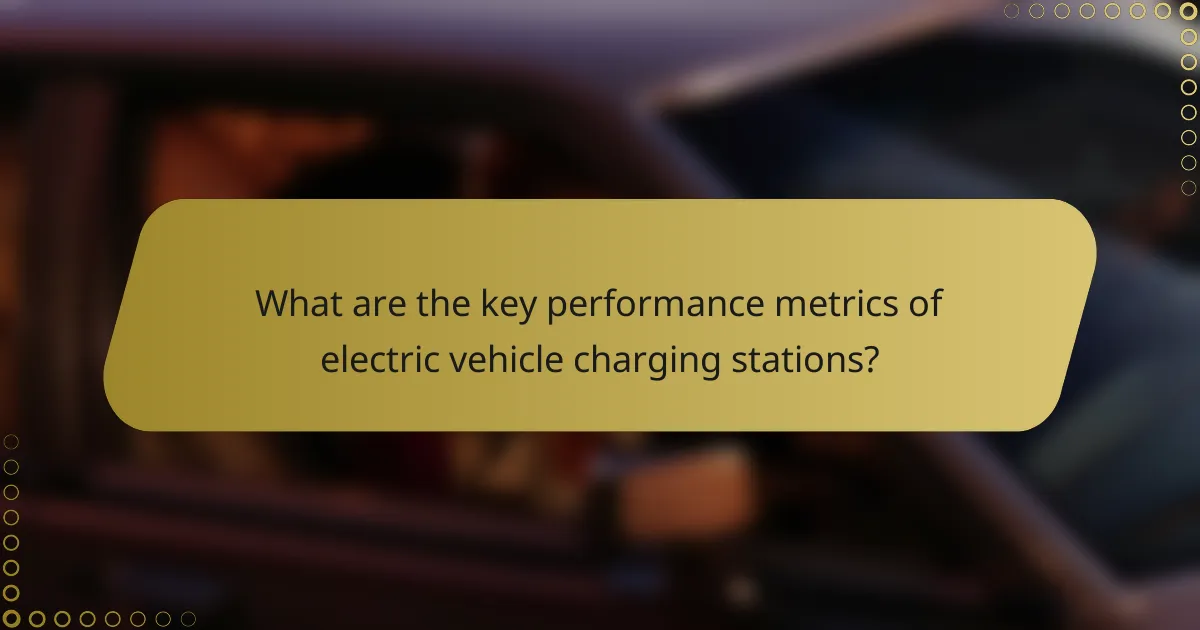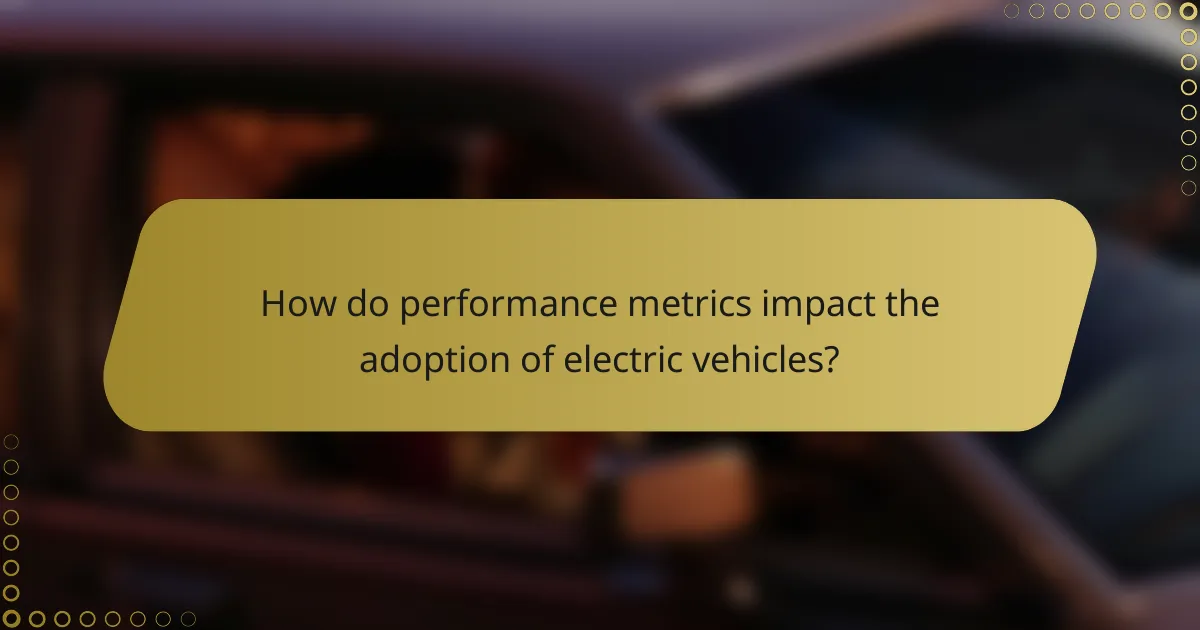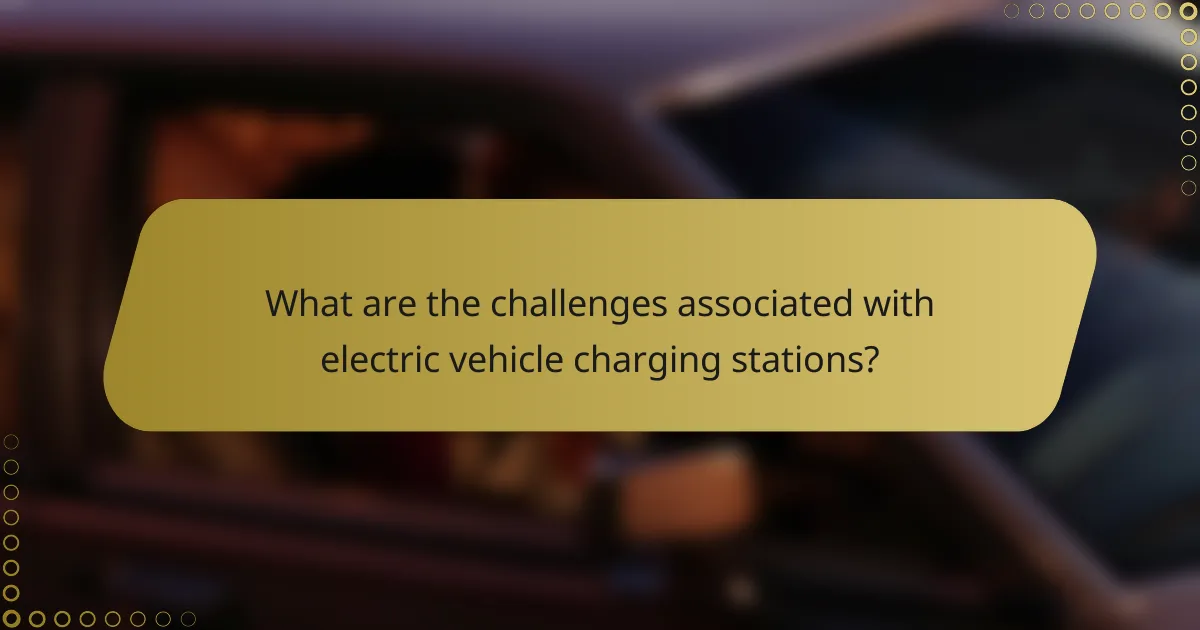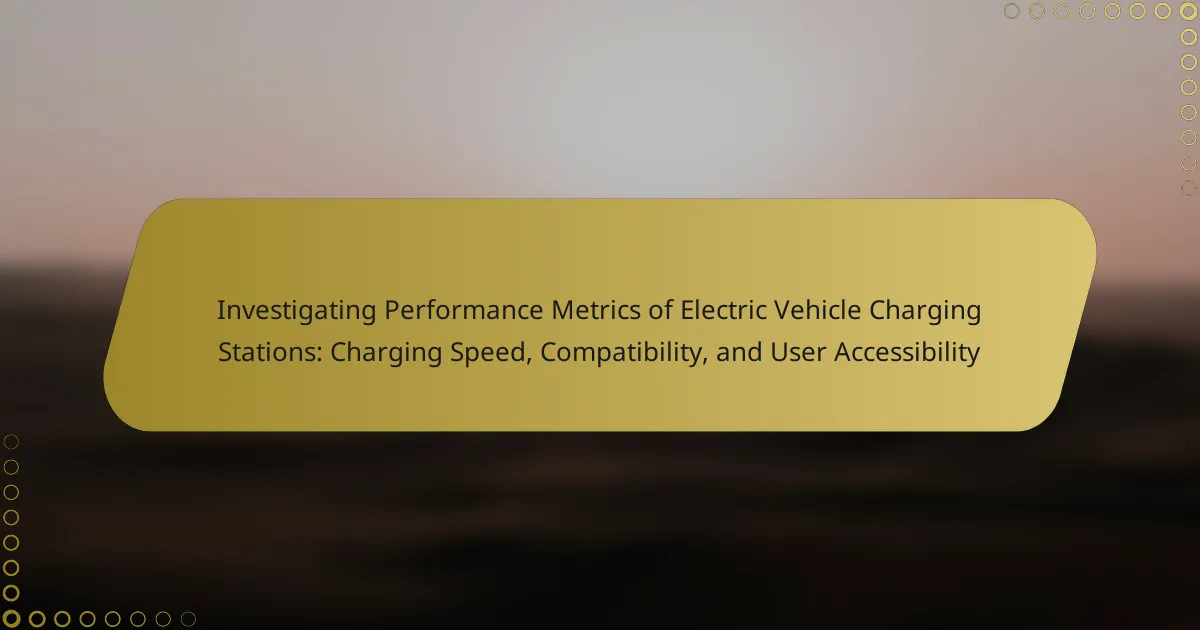The article investigates the performance metrics of electric vehicle (EV) charging stations, focusing on key aspects such as charging speed, availability, and user accessibility. Charging speed, measured in kilowatts (kW), indicates how quickly EVs can recharge, while availability assesses the operational time of stations. User accessibility includes the convenience of location, ease of use, and payment options available to users. The article also addresses challenges faced by charging stations, including limited infrastructure, variability in charging speeds, compatibility issues with different vehicle connectors, and the financial barriers to station installation and maintenance. These factors collectively impact the adoption of electric vehicles by influencing consumer perceptions and decisions.

What are the key performance metrics of electric vehicle charging stations?
Key performance metrics of electric vehicle charging stations include charging speed, availability, and user accessibility. Charging speed is measured in kilowatts (kW) and indicates how quickly a vehicle can recharge. Availability refers to the percentage of time a station is operational and accessible to users. User accessibility encompasses factors such as location convenience, ease of use, and payment options. Additional metrics may include the number of charging ports and the types of connectors offered. These metrics are critical for evaluating the efficiency and user-friendliness of charging infrastructure.
How is charging speed measured in electric vehicle charging stations?
Charging speed in electric vehicle charging stations is measured in kilowatts (kW). This unit indicates the rate at which energy is delivered to the vehicle’s battery. Higher kW values represent faster charging capabilities. For example, a Level 2 charger typically delivers between 3.7 kW to 22 kW. In contrast, DC fast chargers can provide speeds ranging from 50 kW to 350 kW. The actual charging speed also depends on the vehicle’s battery capacity and the state of charge. Additionally, charging speed can be affected by temperature and battery management systems. Understanding these factors helps consumers choose the right charging solution for their needs.
What factors influence the charging speed of electric vehicle charging stations?
The charging speed of electric vehicle charging stations is influenced by several factors. These include the power output of the charging station, which is measured in kilowatts (kW). Higher power output allows for faster charging. The type of charger also plays a significant role; Level 1 chargers are slower than Level 2 or DC fast chargers. Additionally, the vehicle’s battery capacity and its state of charge can affect charging speed. A battery with a higher state of charge will charge more slowly as it approaches full capacity. Environmental conditions, such as temperature, can impact battery performance and charging efficiency. Furthermore, the charging infrastructure and technology used, including communication protocols between the vehicle and charger, influence speed. Lastly, the age and condition of the charging station can also affect its performance.
How do different charging technologies impact charging speed?
Different charging technologies significantly impact charging speed. Charging speed is primarily determined by the power output of the charging station and the vehicle’s acceptance rate. Level 1 charging uses a standard 120V outlet, providing about 1.4 kW, resulting in slow charging times. Level 2 charging, utilizing 240V, can deliver between 3.7 kW to 22 kW, reducing charging time considerably. DC fast charging offers even higher power, typically ranging from 50 kW to 350 kW, enabling rapid charging in as little as 30 minutes for many electric vehicles. The compatibility of the vehicle with these technologies also influences charging speed. Vehicles equipped for higher power acceptance can charge faster at compatible stations.
What types of compatibility exist among electric vehicle charging stations?
There are several types of compatibility among electric vehicle charging stations. These include connector compatibility, voltage compatibility, and communication protocol compatibility. Connector compatibility refers to the physical interface used to connect the vehicle to the charger. Common types include Type 1, Type 2, and CCS (Combined Charging System). Voltage compatibility ensures that the charging station can supply the appropriate voltage levels required by different electric vehicles. Communication protocol compatibility involves the exchange of information between the vehicle and the charger, with standards such as OCPP (Open Charge Point Protocol) being widely used. These compatibilities are essential for ensuring that electric vehicles can charge effectively at various charging stations.
How do charging standards affect vehicle compatibility?
Charging standards significantly influence vehicle compatibility. Different electric vehicles (EVs) utilize various charging connectors and protocols. For example, Tesla uses its proprietary connector, while other manufacturers often adopt standards like CCS or CHAdeMO. This diversity can limit charging options for certain EV models.
Incompatibility may lead to longer charging times or the need for adapters. According to the International Energy Agency, standardization can enhance interoperability among EVs and charging stations. Enhanced compatibility promotes user convenience and broader adoption of electric vehicles. Therefore, charging standards are crucial for ensuring that various EVs can utilize available charging infrastructure effectively.
What are the implications of compatibility for electric vehicle users?
Compatibility for electric vehicle users affects charging station access and vehicle functionality. Users with incompatible vehicles may face limited charging options. This limitation can lead to longer wait times and increased travel distances to find suitable stations. Additionally, compatibility issues can restrict the use of advanced charging technologies. For example, vehicles not supporting fast charging may experience slower recharging times. According to the U.S. Department of Energy, over 80% of public charging stations use the J1772 connector, which is not universally compatible with all electric vehicles. This highlights the importance of compatibility in ensuring convenient and efficient charging experiences for users.
How does user accessibility vary across different charging stations?
User accessibility at charging stations varies based on location, design, and technology. Urban stations often feature better accessibility due to higher demand. They are strategically placed near amenities like shopping centers. Rural stations may have limited access due to fewer locations. Design factors include the height of charging ports and the space available for maneuvering vehicles. Some stations offer ADA-compliant features, enhancing accessibility for individuals with disabilities. Technology also plays a role; stations with user-friendly interfaces improve the overall experience. According to a 2021 study by the International Council on Clean Transportation, accessibility features significantly impact user satisfaction and station utilization rates.
What features enhance user accessibility at electric vehicle charging stations?
User accessibility at electric vehicle charging stations is enhanced by several key features. These include clear signage and navigation aids that guide users to charging locations. Stations often provide multiple charging ports to accommodate various vehicle types. Accessibility features like wheelchair ramps and designated parking spots support individuals with disabilities. Real-time availability updates through mobile apps inform users about open charging stations. User-friendly interfaces on charging units simplify the charging process. Payment options, including contactless payments, enhance convenience for users. Lighting and safety measures improve the overall experience, especially at night. Together, these features create a more inclusive environment for all users.
How does location impact the accessibility of charging stations?
Location significantly impacts the accessibility of charging stations. Proximity to urban areas increases the number of available charging stations. High-traffic locations, such as shopping centers and highways, often have more charging options. Areas with fewer charging stations can lead to longer wait times and limited access. Moreover, rural locations may lack infrastructure, making charging less convenient. According to the U.S. Department of Energy, urban areas have a higher density of charging stations per capita compared to rural areas. This disparity affects electric vehicle users’ ability to recharge efficiently.

How do performance metrics impact the adoption of electric vehicles?
Performance metrics significantly influence the adoption of electric vehicles (EVs). Key metrics include charging speed, range, and efficiency. Faster charging times reduce the wait for users, making EVs more appealing. A longer range alleviates range anxiety, a common barrier for potential buyers. High efficiency translates to lower operating costs, enhancing the overall value proposition. Studies show that consumers prioritize these performance metrics when considering EV purchases. For instance, a survey by the International Council on Clean Transportation found that 70% of potential EV buyers consider charging time critical. Therefore, performance metrics directly affect consumer perceptions and decisions regarding EV adoption.
What role does charging speed play in consumer decision-making?
Charging speed significantly influences consumer decision-making regarding electric vehicles. Faster charging reduces downtime, making electric vehicles more convenient for users. Consumers often prioritize vehicles that can charge quickly, as this aligns with their lifestyle needs. A study by the International Council on Clean Transportation found that charging time is a critical factor for 70% of potential electric vehicle buyers. Additionally, quicker charging options can enhance the overall ownership experience. The ability to charge rapidly can differentiate a brand in a competitive market. Therefore, charging speed plays a crucial role in shaping consumer preferences and purchase decisions in the electric vehicle sector.
Why is compatibility crucial for the widespread use of electric vehicles?
Compatibility is crucial for the widespread use of electric vehicles because it ensures that different vehicles can access various charging stations. When electric vehicles (EVs) are compatible with a range of charging infrastructure, it enhances convenience for users. This compatibility reduces range anxiety, as drivers can charge their vehicles at multiple locations without concern.
Furthermore, studies indicate that a lack of standardization in charging connectors can hinder EV adoption. For instance, in 2021, the International Energy Agency reported that only 35% of public charging points were compatible with all vehicle models. This limitation can discourage potential buyers from choosing electric vehicles.
In addition, compatibility promotes a more extensive network of charging stations, which is essential for long-distance travel. A diverse and accessible charging network can significantly increase consumer confidence in electric vehicle technology. Overall, compatibility is a key factor in driving the growth and acceptance of electric vehicles in the market.

What are the challenges associated with electric vehicle charging stations?
Electric vehicle charging stations face several challenges. One major issue is the limited availability of charging infrastructure. Many regions lack sufficient charging stations, leading to range anxiety among users. Another challenge is the variability in charging speeds. Different stations provide different levels of power, affecting how quickly vehicles can recharge. Compatibility is also a concern. Not all electric vehicles use the same charging connectors, which can limit access for some users. Additionally, the cost of installing and maintaining charging stations can be high. This financial barrier can deter businesses from investing in new stations. Finally, user accessibility remains a challenge. Many charging stations are located in inconvenient areas, making them less accessible for drivers. These factors collectively hinder the widespread adoption of electric vehicles.
What are common barriers to user accessibility at charging stations?
Common barriers to user accessibility at charging stations include inadequate signage, poor location, and lack of physical accessibility. Inadequate signage can lead to confusion about charging station availability and usage. Poor location means some stations are not conveniently placed, making access difficult for users. Lack of physical accessibility refers to the absence of features such as ramps or accessible parking spaces. According to a study by the International Council on Clean Transportation, 30% of charging stations are not compliant with accessibility standards. This statistic highlights the need for improvements in the infrastructure of charging stations to enhance user accessibility.
How can these barriers be addressed to improve user experience?
Barriers to user experience at electric vehicle charging stations can be addressed through several strategies. First, enhancing charging speed can significantly reduce wait times. Implementing high-power charging technology can provide faster charging solutions. Second, ensuring compatibility with various electric vehicle models is crucial. Standardizing connectors and protocols can help achieve this goal. Third, increasing the number of charging stations in accessible locations can improve user convenience. Strategic placement near popular destinations can encourage usage. Fourth, providing clear and user-friendly interfaces on charging stations can enhance usability. Simplifying payment processes and offering mobile app integration can further improve the experience. Finally, offering real-time information on station availability can help users plan better. Studies indicate that these improvements can lead to higher user satisfaction and increased adoption of electric vehicles.
What best practices can enhance the performance of electric vehicle charging stations?
Implementing user-friendly interfaces enhances the performance of electric vehicle charging stations. Clear instructions and intuitive designs improve user experience. Regular maintenance ensures optimal functionality and reliability. This includes checking for software updates and hardware wear. Offering multiple charging options caters to various vehicle types and user preferences. Fast charging capabilities reduce wait times, increasing station turnover. Strategic placement of charging stations in high-traffic areas maximizes accessibility. Data analytics can optimize charging patterns and station usage. These practices collectively contribute to higher user satisfaction and increased adoption of electric vehicles.
How can station operators optimize charging speed and compatibility?
Station operators can optimize charging speed and compatibility by implementing advanced charging technologies. Utilizing high-power charging systems increases the speed at which vehicles can be charged. For instance, deploying DC fast chargers allows for significantly reduced charging times compared to Level 2 chargers.
Additionally, ensuring compatibility with various electric vehicle (EV) models is crucial. This can be achieved by offering multiple connector types, such as CCS, CHAdeMO, and Tesla connectors. Research shows that stations with diverse connector options attract a broader range of users.
Regular software updates for charging stations also enhance performance. These updates can improve communication protocols between the vehicle and charger, leading to faster charging rates. Furthermore, integrating smart grid technology allows for optimized energy distribution, further enhancing charging efficiency.
In summary, the combination of advanced charging systems, diverse connector types, and smart technology integration leads to optimized charging speed and compatibility for station operators.
What strategies can be implemented to improve user accessibility?
Implementing strategies to improve user accessibility at electric vehicle charging stations includes several key actions. First, stations should provide clear signage with large, legible fonts. This helps users quickly identify charging locations. Second, stations must ensure compatibility with various electric vehicle models. This reduces barriers for users with different vehicles. Third, providing accessible features such as ramps and designated parking spaces is essential. These features help users with mobility challenges. Fourth, offering user-friendly interfaces on charging machines can enhance the experience. Interfaces should include multiple languages and visual aids. Fifth, mobile apps that guide users to the nearest charging stations improve accessibility. These apps can provide real-time information on station availability. Lastly, regular feedback from users can identify areas for improvement. This feedback ensures that accessibility needs are continually met.
The main entity of this article is electric vehicle charging stations, examined through the lenses of performance metrics such as charging speed, compatibility, and user accessibility. Key performance metrics include the speed of charging measured in kilowatts, the operational availability of stations, and factors impacting user accessibility like location and payment options. The article delves into how charging speed varies by technology and vehicle compatibility, the implications of these metrics on consumer decision-making, and the challenges faced by charging infrastructure. Additionally, it outlines strategies for enhancing user experience and accessibility at charging stations, aiming to promote the adoption of electric vehicles.
